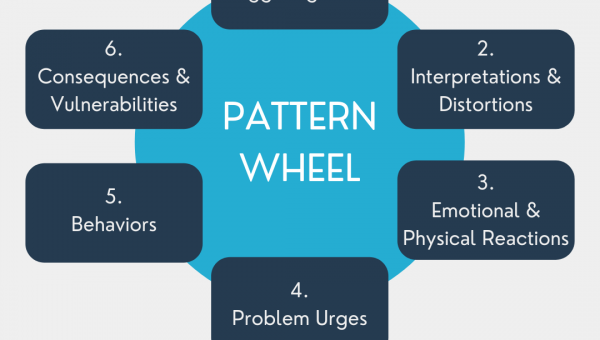As previously mentioned, trauma has a way of throwing our lives out of sync in many different ways and directions. In this blog, we will focus on how trauma affects two mental processes: awareness and acceptance.
When awareness and acceptance are altered enough, we enter into a mindless state. Two examples of mindlessness especially experienced by trauma survivors include reactivity and dissociation. These alterations to our mental processes are adaptive—and necessary—during periods of danger. But, unfortunately, these adaptions outlive the trauma itself—and, therefore, they also outlive their usefulness. That’s why you will soon learn a skill called mindfulness, which helps us restore both awareness and acceptance to our daily lives.
Imbalanced Awareness
In the introduction, we discussed how trauma has a way of throwing us off balance by forcing our normal way of doing things to the extremes. One of the first things that trauma knocks off balance is our awareness.
When we experience trauma, we are forced to pay attention to things we wouldn’t normally pay attention to. In particular, trauma causes us to focus on information that is directly related to our survival, while focusing less on everything else. For instance, if you are walking through the park and there is no reason to suspect any danger, you are likely to notice—and appreciate—the flowers, the birds, people walking their dogs, and children playing. But if you are walking through the park and you suddenly hear multiple gunshots, you will notice a completely different set of details—the sound of the gunfire, the direction of the shots, the closest place to duck for safety—and ignore everything that doesn’t serve your safety.
Of course, our brain’s ability to shift our awareness during periods of danger makes complete sense and is highly adaptive; without this ability, we would not be able to survive the trauma. However, our brain also seems to overlearn this tendency. Even after the trauma has long ended, our overall awareness remains altered, and we continue to over-focus on some details while under-focusing on others—even though our survival is no longer at stake. This ongoing altered awareness ends up causing lots of additional problems in our lives. We may even become obsessed with minor details while completely ignoring major problems.
Extreme Judgments
Not only does trauma force our awareness to the extremes, it also forces something else to the extremes: our judgments. When we experience trauma, everything becomes a matter of life and death, and we don’t have a ton of time to distinguish between the two. Therefore, our brain makes quick, snappy judgments: good or bad, safe or unsafe, friend or foe.
Once again, the brain’s ability to make rapid, simple judgments in times of danger is highly adaptive and allows us to survive the trauma. But the brain also seems to overlearn this tendency as well, which likewise causes even more ongoing problems down the road. With our extreme judgments overactivated, it is much more difficult to accept other perspectives, gray areas, or the middle ground. In other words, trauma does not just affect our awareness; it also affects our acceptance.
Mindlessness
To be mindless means to be unaware: of yourself, of others, of your thoughts and feelings, of your triggers and urges, of your reactions, and even of your judgments. And since you are unaware of your own judgments, you lack both awareness and acceptance whenever you are in a state of mindlessness.
Not surprisingly, there are many forms of mindlessness. However, people who have been traumatized tend to adopt two forms in particular: reactivity and dissociation.
“Reactivity” means to respond with our instincts or emotions without thinking first. Once again, this tendency is highly adaptive during periods of danger. We need to be reactive in order to survive a crisis. When we are in a life-or-death situation, we would be foolish to call all of our friends and ask for their opinions. However, this reactivity continues long after the trauma has stopped. In particular, trauma survivors tend to be very reactive to anything that reminds them (even remotely, indirectly, or subconsciously) of a previous trauma—which, not surprisingly, causes even more ongoing problems.
Dissociation literally means to disconnect from your own experiences. In other words, it means to “space out” for long periods of time. Dissociation is much more severe than simply daydreaming, which we all do at times. And you probably already know what I am going to say next: “Once again, this tendency is highly adaptive during periods of danger.” In fact, the ability to mentally and emotionally disconnect from our own experiences during times of trauma is precisely what helps many people survive the trauma itself. But by now you already know this familiar tune: Asset then, liability now. Chronically disconnecting from our daily experiences is simply not an effective, long-term strategy for a happy, productive life.
But let’s be clear: Since some states of mindlessness help us survive trauma, mindlessness truly is a gift of the mind (you won’t hear too many DBT therapists tell you that!). However, mindlessness alone is also a rotten way to go through life. What if you were always reactive—to everything? What if you were always spacing out, even during your most cherished moments? What if you were always making quick, snappy, and sometimes very inaccurate judgments? That’s why we also need the opposite of mindlessness, which is mindfulness.
WHAT IS MINDFULNESS?
Wouldn’t it be amazing if there was something that could restore both awareness and acceptance back to their normal balance? Wouldn’t it be amazing if you could notice—and even appreciate—flowers and birds and dogs and children in the park again, instead of focusing on every person you come across as the next armed attacker? Well, I have great news for you: There actually is a skill that teaches both awareness and acceptance at the same time! It’s called mindfulness.
















